Monthly INsync Chit Chat July 2024
Most of the Time… [by David Cox]
Some of you know that I bought a motorcycle last year, having had my license since I was 16 years old. This past month, I rode it most days (yes, you know I have the data to prove it!) and even to the office quite a few times. I have to say that living in St. Jacobs (north of Waterloo) and being surrounded by countryside really is the perfect place for a ride. No, I’m not talking about high pitched, whining, 2-stroke “crotch-rocket” type motorcycles. You know, those racing bikes with flashy colours that zoom by you in your car and you shake your head at the blur. That’s not me! Picture the big bike cruising type, puttering along, smiling as the fresh air blows.
We played a family game of Monopoly last week and it really was an interesting game. Dad (that would be me) bought properties he landed on but didn’t want to leverage for housing or push his finances too hard for fear of getting hit with rents, taxes or bills that he couldn’t afford. Asha (17) on the other hand, dealt and negotiated aggressive deals for big property groups and built housing and hotels with incredible determination – construction labour shortages or materials inflation? [trying to make you giggle here]. That mattered not to him. I thought it seemed excessive. But in the end, he crushed us. It’s expensive enough at home, staying in hotels often adds a lot to the expenses and frankly drove the rest of us for broke. The rich get richer I guess they say (which is why Trudeau and our government is now saying that it’s those that have saved money, “whose money is working for them,” to have to turn around and give some to those who instead are just starting their careers.)
News – Some That You’ve Heard, Most That You Haven’t [by David Cox]
Bill C63 retroactively will allow the Canadian government to search the web and social media for “hate speech” (which includes speaking out against government policies) with long jail sentences possible. Saudi Arabia failed to renew its 50-year agreement to primarily use the U.S. dollar for oil sales [NOTE: I needed to turn on a VPN to confirm these June stories, which don’t seem available in North America and are likely be censored from us]. Russia announced that it is “comfortable” using the Chinese Yuan for settlements of oil trade. Saudi Arabia announced that they are open to accepting Bitcoin in the future for (oil) trade. The increased capital gains taxes levied by the Canadian federal government will provide additional revenue to the tune of about 5 days of spending at current rates [cdn taxpayer federation]. Norinchukin Bank (a Japanese institution) to sell $63 billion worth of bonds as losses are realized and the yield curve crushes them (pre-cursor to what’s to come everywhere else?). CMHC quietly notified lenders they’ll be extending maximum amortizations and the developer bailout will help borrowers repay their loans over two generations (and extend up to 55 years).
Things We Recommend [by David Cox]
I’ve always been the kind of person to try to stay in shape and diversifying from an only cardio regiment feels right. I’ve had my share of gym memberships over the years and have made more than my share of excuses as to why I didn’t go this day, or that day (can you relate?). I always laughed in January when the gym packed up for the first few days and weeks, and then petered off, as New Year’s resolutions failed, and old habits were easier to sink back into.
But I invested in a home bench and cast-iron weights a couple of years back and for that I’m grateful. No need to spend time driving to a gym, or packing a bag to clean up afterwards. It’s just a matter of getting down to business. I had found that 5x5 progressive workout a solid challenge, but more recently I’ve migrated to a three day per week routine and do a variety of bench and shoulder presses, squats, deadlifts, rows and curls. We have to treat our bodies well if we want them to have a greater chance of lasting, and strength training is something that can be done with even the simplest of dumbbells at home, perhaps even in front of the TV, where the data suggests many spend significant amounts of time (although surely, it’s more computers these days, no?). What about you?
Book Corner [by David Cox]

I know you all know that I love charts, but we all need to “diversify,” right? This book was recommended by a client, and I ordered right away. And geesh, if you’re open minded, it sure changes one’s perspective of some of the practices that we consider common these days in food and health.
Sure, I think we can all admit that there is a lot of money involved and profit-seeking that drives advice in the health industry, by those big drug companies. There were so many actionable ideas in this book, although admittedly almost too many!! We all need our health in order to spend time with our families and friends, to travel and to enjoy whatever it is we like doing. If you’re one of those that doesn’t always want the status quo opinion, you might like this book!
What Are We Buying? Selling? Holding… [by David Cox]
Last month, we discussed copper stocks in this column, and this month, I want to dig in to First Solar ($FSLR), what was clearly the early (and remaining) leader from the industry group. On the whole, the group of stocks that make up this area have much work to do to establish some traction. But First Solar woke up in March (first green circle) and proceeded to break out, becoming more clearly the leader and then the sudden and massive momentum stock it was through April, even as the stock market itself corrected.
But all trends end eventually and this one needs a pause in the short-term to consolidate and back and fill, so to speak, to gain enough energy to build up for another potential leg of action. It experienced somewhat climactic action into the recent highs, faced an overbought RSI(5) bearish divergence (lower high in that indicator in the lower panel) and then sold off. That said, at this point, it does still look like a respectable and controlled correction, and you can bet I’m watching it carefully. Time frames matter for investors. A more aggressive investor can take profits sooner, and then even contemplate buying back in, if desired, whereas trying to sit tight on big new potential leaders can lead to significant longer-term rewards for more patient folks. We do a bit of both for our clients, depending on their risk tolerance and market conditions and I know that you know, these chart mark-ups aren’t just some passing hobby. These are actionable areas (in hindsight), and I hope providing these insights can help you gain perspective on ideas related to your own investment strategy (if of course you’re not already a client!!).
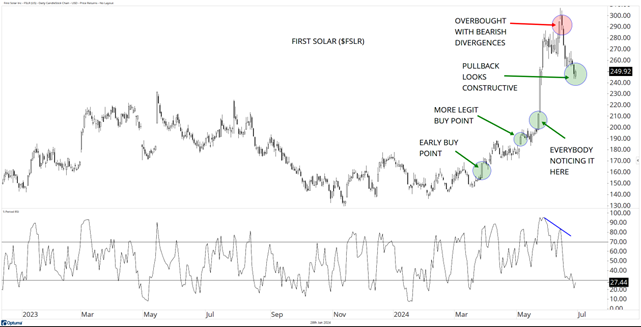
Source: Optuma
* * as at June 28th, 2024
Lifestyles to Consider! [by Criselle Tung]
Did you know that skin cancer rates have been steadily rising in Canada over the past 30 years? With summer here and more time spent outdoors, our exposure to the sun increases, making UV protection essential.
First off, stay hydrated! Drinking plenty of cool liquids, especially water, is crucial during these warmer months. Not only does it support overall bodily function, but it also enhances skin health. If plain water sounds boring, try infusing it with lemon, cucumber, and mint. You can even add some fizz for a twist! Additionally, eating foods with high water content such as watermelons, strawberries, and peaches can also keep you refreshed.
Skin protection is just as important. Even animals know how to beat the sun! Chimpanzees chill in the shade during peak hours and hippos secrete their own sunscreen - a natural pink oil. When the UV Index is 3 or higher (typically from 11am to 3pm in Canada), even if it’s cloudy, use sunscreen labeled “water resistant” with an SPF of at least 30. If you’re out of sunscreen, cover up with light-coloured long sleeves with breathable fabric, and don’t forget your sunglasses to protect your eyes from UV exposure. If it’s too hot to cover up, then limit your time in the sun – stay in the shade and always bring an umbrella with you.
Lastly, after-sun care is also a must! Soothe sunburns with aloe vera and moisturizing lotions. Make smart choices and enjoy a safe, sun-kissed summer!
How’s the (Bigger Picture) Market? [by David Cox]
Despite the continued discussions and voiced concerns about the deterioration in market breadth (i.e., the # of stocks rising as the stock market indices continue to rise), the market is for sure rising. But yes, the biggest of the stocks are driving the ship, however, I assure you, there are still lots of signs of life underneath this market and outside the name-brand indices (Conor will discuss indices in more details in “We All Need to Keep Learning!” section below). Every time the markets make a defined low, or break out above a prior level, we can draw a horizontal line to manage risk. Yes, the weekly S&P 500 is back to RSi(5) overbought which does mean chasing comes with higher risk. But the bigger picture? Uptrend.
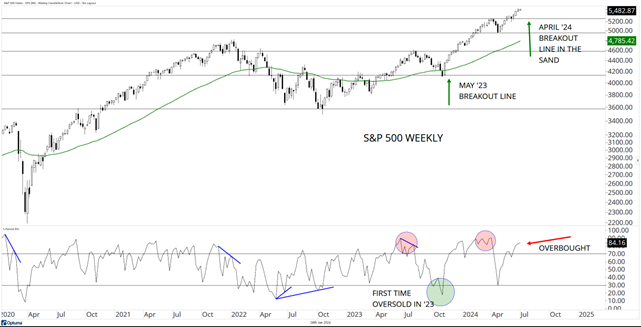
Source: Optuma
* * as at June 28th, 2024
Market Summary and Trend of “All Assets” [by David Cox]
Despite the naysayers and the headlines, which are seemingly and so often designed to stoke fear, risk assets continue to behave very well. Yes, we had signs of life in areas like Europe and emerging markets, and those have suffered deterioration again as of late. Although not shown, the long-term relative charts of key geographic areas in the world continue to make clear that the U.S. stock market is the strongest market in (the global) town, and it will only change when it changes. I covered the importance of zooming out several times in the “Where Do We (Investors) Stand?” webinar on Friday, June 28th. Perhaps a good refresher on why short-term data can mislead us as investors.
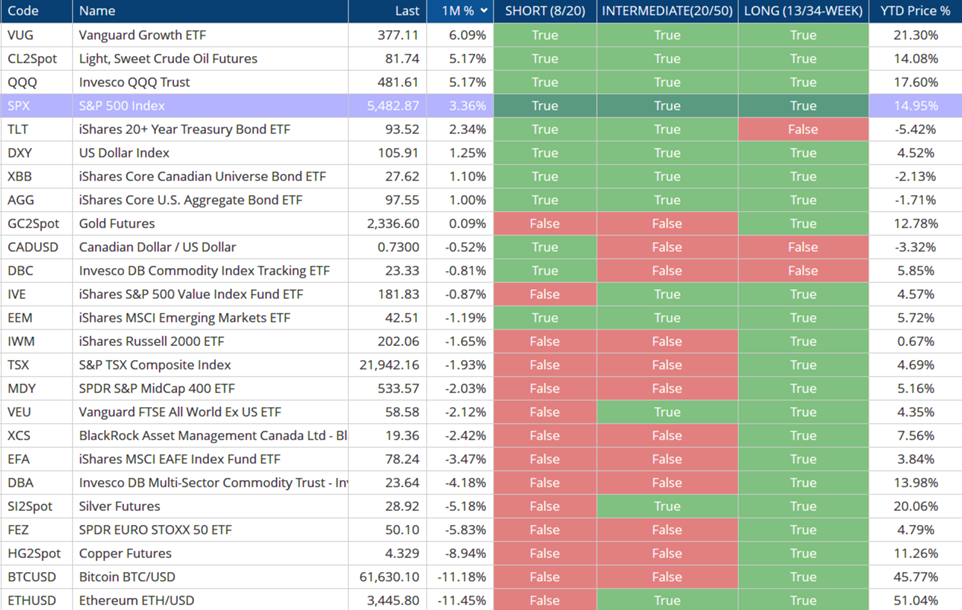
Source: Optuma
* * as at June 28th, 2024
We All Need to Keep Learning! – “Key Stock Market Indices and What They Mean” [by Conor White]
Investing can often seem complex, especially when you encounter terms that you’ve never heard before or hear someone refer to something like an “index.” However, understanding these terms is useful for anyone who is looking to make informed decisions. In this piece, we’ll look at the major indices you should know about and why they matter.
What is an Index?
A stock market index reflects the composite value of a select group of stocks. An index is designed to represent the overall performance of a particular market (such as U.S. or Canada) or a particular sector of the market (such as energy). By tracking the changes of these groups via an index, investors can get a sense of how a particular market or sector is performing over time.
Why Do They Matter?
- Benchmarking performance: Investors use indices as benchmarks to gauge the performance of their investment portfolios. By comparing their returns to those of a relevant and comparable index, they can determine how well they are doing.
- Market Sentiment: Indices can provide a snapshot of market sentiment. A rising index generally indicates investor confidence while a falling index would suggest the opposite.
- Economic Indicators: Policymakers and analysts use indices to assess the economic health of a country or specific sector and as such, they are often cited in economic reports and news articles.
- Investment Products: Many investment products, such as mutual funds, and exchange-traded funds (ETFs) are designed to track specific indices. This allows investors to invest in a broad market segment without having to buy individual stocks.
Key Market Indices
The Dow Jones Industrial Average (DJIA) is one of the oldest and most well-known indices in the world. It is comprised of 30 large, publicly traded companies based in the United States. Often referred to simply as “The Dow,” this index is seen as a barometer of the overall health of the U.S. economy. Companies in the Dow are generally seen as leaders in their respective industries, making it a valuable gauge of industry performance.
The S&P 500 (SPX) includes 500 of the largest publicly traded companies in the United States. It is widely regarded as one of the best representations of the U.S. stock market. Most investors prefer the S&P 500 over the Dow because it includes a larger and more diverse group of companies.
The S&P/TSX Composite Index is the main index for the Canadian market. There are 222 constituents and is heavily weighted towards the financial sector.
The NASDAQ Composite (COMP) index is comprised of more than 2,500 stocks that are listed on the Nasdaq stock exchange, which is known for being very tech-heavy. As such, the index is very useful for investors who are interested in the technology sector.
The Russell 2000 (RUT) index tracks 2,000 smaller companies in the U.S. and is most often used to gauge the performance of small-cap stocks. It provides insights into the health and trends of smaller, more domestically focused companies.
The FTSE 100 is comprised of the 100 largest companies listed on the London Stock Exchange. The index is a primary indicator of the performance of the UK stock market and economy.
The Nikkei 225 includes 225 of the largest companies listed on the Tokyo Stock Exchange and provides insights into the performance of Japan’s diverse industries.
Indices are essential tools for us investors. Keep these on your radar, and you’ll be better equipped to understand and respond to the ever-changing dynamics of the global stock market!
This Month in Innovation [by Conor White]
Startup Brings New Hope to the Pursuit of Reviving Frozen Bodies.
SpaceX’s Starship Rocket Successfully Completes 1st Return From Space.
Ilya Sutskever Has a New Plan for Safe Superintelligence.
One UPtrend, One DOWNtrend [by David Cox]
In what has got to be one of the most boring type of businesses, investors in relative strength and those that embrace trend following certainly know of Dollarama ($DOL:TSX). What a beast of a stock. In fact, this is one of the stocks that has managed to outperform the S&P 500 on a 1, 2, 3, 4, 5 and 10-year time frame, meeting the #INsyncUniverse screen. But dollar stores and cheap, disposable goods? Yep.
Contrast that chart with Magna International ($MG:TSX), one of the large-cap auto parts companies started in a garage (just like its smaller peer, Linamar ($LNR:TSX)) which has been declining for the past few years. Why? I don’t know. Economic woes? Concerns about Canada? Regulatory risk? Ex-CEO and founder headlines? Who knows. But a trend is a trend, and that’s why we find them and acknowledge them, so they can help us make decisions, all of which contribute to our own investment portfolios and the desire to see those equity curves go from the lower left to the upper right.
If you want your portfolio to rise, it makes sense to own things that are rising! Keep it simple!

Source: Optuma
* * as at June 28th, 2024
We Like Fundamentals Too! [by David Cox]
Dutch Bros ($BROS) is a $7.4 billion market-cap company that operates 831 drive-through coffee shops in 18 states in the U.S. I’ve admittedly never been to one, but the restaurant industry group has been showing signs of life in the last few months (that means improving in relative strength) and so the stock has been back on my radar. It IPO’d back in 2021 and subsequently peaked, while falling from its highs around $80 to the lows around $20 (yes, that’s -75%!).
Check out the sales growth in the table below. That’s the year-over-year growth and I’ll tell you double digit sales growth is good, +30%+ is very impressive. And consistent as you can see. It looks like earnings are starting to develop and we can’t be surprised to see that the institutions are taking notice. That second table (below on the right) shows that we have what we call a 4-quarters rising stock, meaning more and more of those big, reporting institutions are identifying themselves as shareowners. More big shareowners equals more potential demand and adds to the “fundamental.” Are they all drinking coffee at Dutch Bros these days? Have you been? Let me know what you think and if I should put it on my list to track down next time I’m travelling!

Source: MarketSurge
* * as at June 28th, 2024

Source: Optuma
* * as at June 28th, 2024
The stock broke out this spring (green circle) and has moved up since and is trying to move out above those early ’23 highs. All we can do is watch and we can manage risk as investors. But when the stock market (S&P 500) is moving upwards, and the sector (consumer discretionary) is moving upwards, and the industry group (restaurants) is moving upwards, and the stock is moving upwards, we’re focused on something gaining the attention of investors.
Chart of the Month [by David Cox]
The last four years since the #COVID crash have been remarkable to say the least. Interest rates bottomed at negative to low (basically zero) rates and have moved up, largely, since. As investors, we need to allocate our portfolios accordingly and by comparing one asset to another, that’s exactly what we can do. Typically, so called “balanced” investors have embraced an almost default 60% equities/40% fixed income (bonds) exposure, which is what most would call “textbook.” Most that know me well, know that I don’t believe in generic type advice, but to say the last several years have been challenging for those balanced fund investors is perhaps an understatement. Add to it that many of those investors like dividend stocks (another weak relatively underperforming area because of rates) and it adds to woes.
Anyways, here’s the S&P 500 ($SPX) vs. U.S. long treasury bonds ($TLT). A very clear uptrend over the last four years. It’s not about forecasting or predicting, it’s about noticing and acknowledging.
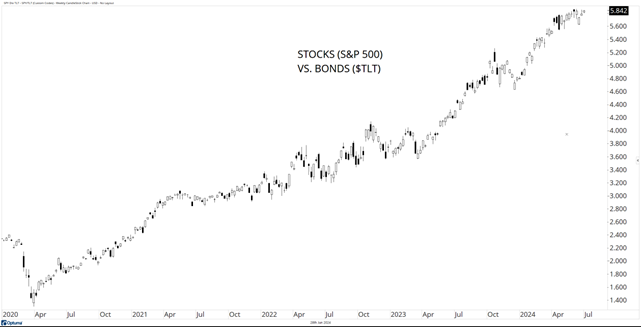
Source: Optuma
* * as at June 28th, 2024
Social Media and Our Website [by David Cox]
This past month, I had my most viral tweet ever and while not one to admittedly care about such arguably superficial things, it is interesting when out of nowhere, your comments cause action and garner attention. I showed one of my long ATR (average true range) models below and was suggesting investors shouldn’t be so keen to be bearish (yet). Then, a day later, pointing out the overbought conditions on the Nasdaq, more eyes and views on my work. I point out what I see, I journal away, and I share because it’s fun and honestly, we all need to learn what we can to strive to be better investors!
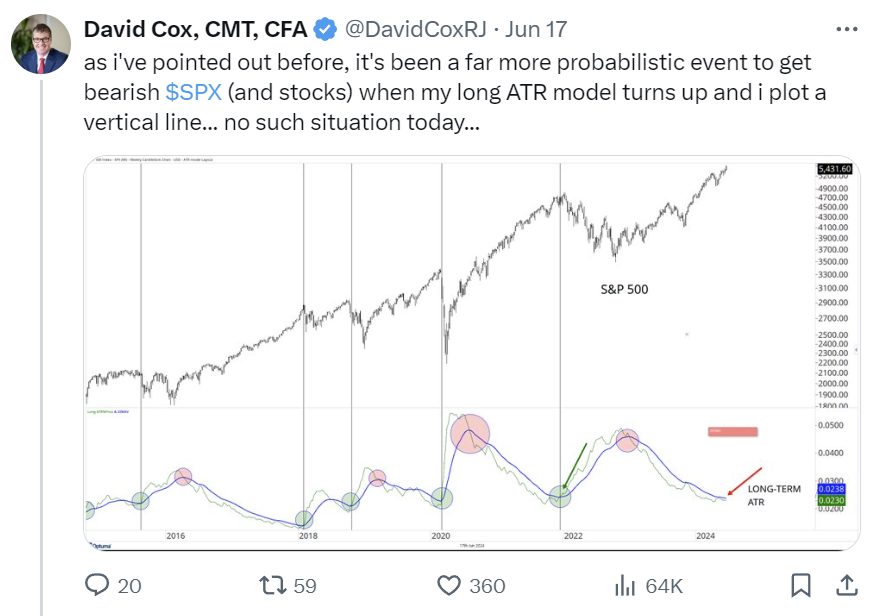
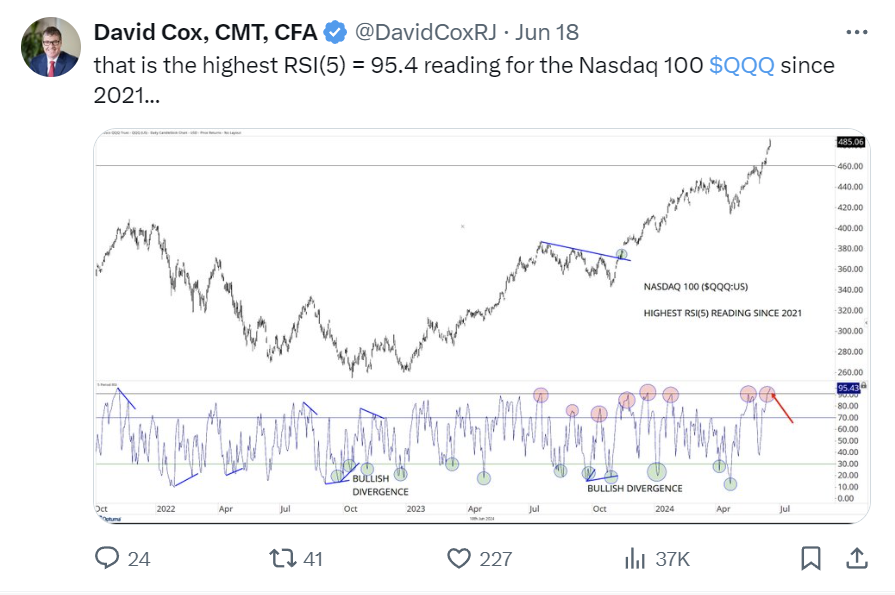
Upcoming Dates, Seminars, and Announcements [by David Cox]
What: Bitcoin 2024 Conference
Where: Nashville, TN
When: July 25-27th, 2024
Who: I’m very excited to check out this growing event!
What: Rossland/Trail, British Columbia
When: September 9-16th, 2024
Who: Visiting with B.C. clients!
What: Nomad Capitalist Live!
Where: Kuala Lumpur, Malaysia
When: September 25-28th, 2024
Who: Another long flight, but the conference looks VERY awesome!
Thanks for reading our “Monthly “INsync” Chit Chat”! Please don’t hesitate to offer comments, criticisms, or ideas to make this a more valuable publication. Thanks in advance!
Sincerely,
David Cox, CFA, CMT, FMA, FCSI, BMath
Senior Portfolio Manager, Wealth Advisor
Raymond James Ltd.
Phone: 519.883.6031
Unit 1 – 595 Parkside Drive | Waterloo, ON | N2L 0C7
david.cox@raymondjames.ca
www.financiallyinsync.com
![]() @DavidCoxRJ
@DavidCoxRJ
Disclaimer: Information in this article is from sources believed to be reliable, however, we cannot represent that it is accurate or complete. It is provided as a general source of information and should not be considered personal investment advice or solicitation to buy or sell securities. The views are those of the author, Financially INsync Team, and not necessarily those of Raymond James Ltd. Investors considering any investment should consult with their Investment Advisor to ensure that it is suitable for the investor’s circumstances and risk tolerance before making any investment decision. Statistics, factual data and other information are from sources believed to be reliable but accuracy cannot be guaranteed. It is furnished on the basis and understanding that Raymond James Ltd. is to be under no liability whatsoever in respect thereof. It is for information purposes only and is not to be construed as an offer or solicitation for the sale or purchase of securities.
Raymond James Ltd. is a Member Canadian Investor Protection Fund.
Raymond James (USA) Ltd. (RJLU) advisors may only conduct business with residents of the states and/or jurisdictions for which they are properly registered. Raymond James (USA) Ltd., member FINRA/SIPC.
